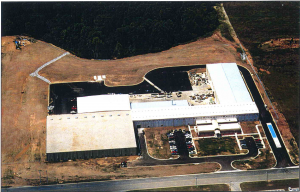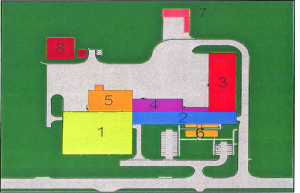Tuscaloosa’s Alabama Paper Products, a subsidiary of Maryland Paper Products, opened its doors in November of 2002 after a “fast-tracked” (2) construction process, only taking a single year from breaking ground to completion (2). Maryland Paper Products and its subsidiaries synthesize 100 percent post-consumer cellulose waste into paper, and sell it to companies that produce industrial paper products such as dry felt (used for roofing under-layers), insulation facing, high-strength pallets, and a 100 percent biodegradable industrial-strength paper product called RHIMAX® (3). The CEO of the company, Matthew Chakola, was born and raised in South India, eventually coming to the United States as an adult. After pursuing a Master’s degree in Engineering Mechanics at Widener University, he founded the Maryland Paper Company in 1989 (6), and his business skill led him to expand his operations with a plant in Tuscaloosa in 2002, and a factory in California, which opened in 2013.
The three facilities employ 150 personnel (3), and the Tuscaloosa factory specifically employs 98 individuals (1), 33 more than Chakola’s original estimates (2) (7). Using waste materials from Tuscaloosa, Birmingham, and Atlanta markets, Alabama Paper Products is able to make their paper more cheaply and efficiently than their competitors (2) (7). In a period when other paper mills are closing down and laying off workers (7), Chakola’s business is thriving: the Tuscaloosa plant was constructed with auctioned-off machinery from closed-down paper mills (2), uses waste cellulose – a cheaper input than virgin wood pulp (7) – and Alabama Paper Products accrues about $15 million in revenue yearly (1). In all, Chakola’s factories collectively produce the most roofing felt from recycled paper in the United States (6). Understandably, the wage/salary numbers for Alabama Paper Products are not public, but employee occupations range from office work to technical jobs, as well as laborers (7).
While Alabama Paper Products generally shines in its environmental impact, over the past three years, there were two consecutive quarters during which the EPA found the facility in non-compliance with the Clean Water Act. However, the EPA took no formal measures and the factory quickly moved to comply with the regulations (4). With that minor issue aside, the commitment to environmental sustainability at Alabama Paper Products is impressive. The business processes roughly 83,000 tons of post-consumer waste – cardboard and paper – and produces around 75,000 tons of paper annually (3) (7). Unlike in the production of paper using virgin wood pulp, the water involved in the production of recycled paper can be perpetually reused until the water evaporates or is finally used up entirely in the manufacturing process (7). Also, Alabama Paper Products captures its share of Tuscaloosa’s average yearly rainfall of 54.91 inches in its 50,000 gallon catchment system, and uses it in its paper-making process (2). In addition, Alabama Paper Products produces no effluent (liquid waste dumped into the surrounding area) (7) (8), and uses a “chemical free” (7) process in order to further protect the environment. Curiously, although common knowledge and sustainable marketing would tell a conscientious consumer that by purchasing recycled goods, trees are saved, this is not the case due to the fact that trees are commodity goods and are thus grown to be used (10).
The video above was furnished courtesy of WAR Construction, and it was created to tell the story of the construction of Alabama Paper Company and expound upon its beneficial effects for Tuscaloosa. The below video was commissioned by Maryland Paper Company (the parent company of Alabama Paper Products) to explain its history, showcase its stellar business plan, and educate citizens and potential clients of its commitment to environmental sustainability.
Sources:
2. http://www.warconstruction.com/wp-content/uploads/2012/12/Alabama-Paper-Products-Award-Entry.pdf
3. http://www.marylandpaper.com/
4. http://echo.epa.gov/detailed-facility-report?fid=110020397649#pane3110020397649
5. http://companies.findthebest.com/l/10925912/Alabama-Paper-Products-Llc-in-Tuscaloosa-AL
6. http://www.mathewchakola.com/index.html
7. https://www.youtube.com/watch?v=v56Z9HO3eaY
8. https://www.youtube.com/watch?v=jv0_Fv0YmWU
9. http://www.usclimatedata.com/climate/tuscaloosa/alabama/united-states/usal0542
10. http://www.aeconline.org/recycling/materials/papers/office-paper

